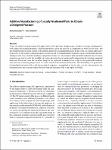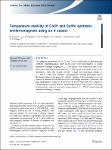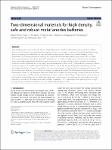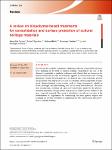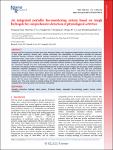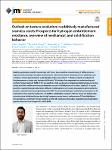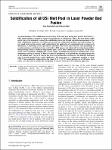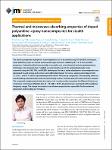Search
Author
- Osman, Ahmed I. (5)
- Daqing, Ma (3)
- Jorgensen, Ed (3)
- Li, Yan (3)
- next >
Subject
- kinh tế (26)
- Economics (12)
- programming (10)
- XRD (10)
- next >
Date issued
- 2020 - 2025 (2129)
- 2010 - 2019 (129)
- 2000 - 2009 (9)
- 1999 - 1999 (1)
Has File(s)
Search Results
Today, the additive manufacturing (AM) approach has led to profound changes in part and process design, enabling previously impossible material properties. With the freedom to create the material as components are built layer by layer, AM has permitted precise spatial control of the material properties in manufactured parts. In this work, an original approach is proposed to locally control component and process design and create intentionally weakened regions with designed fracture, which paves the way to tuneable mechanical properties. Tensile tests of specimens with embedded weakened area of various geometries are used to verify the feasibility of a-priori-designed fracture modes and to characterise the variation in material behaviour. The results show that an ad hoc design of the... |
The magnetic properties of Co/Pt and Co/Pd multilayers of perpendicular synthetic antiferromagnets with an Ir spacer were investigated. A strong interlayer exchange coupling of Jex=2.01
erg/cm2
was observed in the Co/Pt-based structures and a lower value of Jex=1.04
erg/cm2
was found in the Co/Pd multilayers. Only the former revealed a high post-annealing stability at Ta=330∘
C, as the latter exhibited a ferromagnetic coupling most likely due to the deterioration of the spacer by pinhole coupling. This assumption was confirmed by theoretical calculations of the total energy functional. Moreover, the high temperature stability of Ir-based Co/Pt p-SAF structures was verified by calculating the exchange field Hex
from magnetization M(H) loops as a function of temperature, wh... |
With a high specific capacity and low electrochemical potentials, metal anode batteries that use lithium, sodium and zinc metal anodes, have gained great research interest in recent years, as a potential candidate for high-energy-density storage systems. However, the uncontainable dendrite growth during the repeated charging process, deteriorates the battery performance, reduces the battery life and more importantly, raises safety concerns. With their unique properties, two-dimensional (2D) materials, can be used to modify various components in metal batteries, eventually mitigating the dendrite growth, enhancing the cycling stability and rate capability, thus leading to safe and robust metal anodes. In this paper, we review the recent advances of 2D materials and summarize current ... |
Nowadays, the scientific community emphasizes the use of reversible and non-toxic materials in the field of cultural heritage. Biopolymers are one of the alternative materials to synthetic polymers and solvents that are dangerous for human health and for the environment, applied in consolidation and coating treatment. Natural biopolymers may be divided into polysaccharide, protein, and polyester: All of them are low cost, eco-friendly, and biocompatible, besides many physicochemical characteristics such as being transparent, soluble in water, hydrogel, and film-forming, and can be easily functionalized. The addition of nanoclay, essential oil, and active molecules improves the physicochemical properties of biopolymers and proposes smart response abilities to the new composite materi... |
Cellulose has experienced a renaissance as a precursor for carbon fibers (CFs). However, cellulose possesses intrinsic challenges as precursor substrate such as typically low carbon yield. This study examines the interplay of strategies to increase the carbonization yield of (ligno-) cellulosic fibers manufactured via a coagulation process. Using Design of Experiments, this article assesses the individual and combined effects of diammonium hydrogen phosphate (DAP), lignin, and CO2
activation on the carbonization yield and properties of cellulose-based carbon fibers. Synergistic effects are identified using the response surface methodology. This paper evidences that DAP and lignin could affect cellulose pyrolysis positively in terms of carbonization yield. Nevertheless, DAP and lig... |
Advanced soft ion-conducting hydrogels have been developed rapidly in the integrated portable health monitoring equipment due to their higher sensitivity, sensory traits, tunable conductivity, and stretchability for physiological activities and personal healthcare detection. However, traditional hydrogel conductors are normally susceptible to large deformation and strong mechanical stress, which leads to inferior electro-mechanical stability for real application scenarios. Herein, a strong ionically conductive hydrogel (poly(vinyl alcohol)-boric acid-glycerol/sodium alginate-calcium chloride/electrolyte ions (PBG/SC/EI)) was designed by engineering the covalently and ionically crosslinked networks followed by the salting-out effect to further enhance the mechanical strength and ioni... |
Realizing application specific manufacture with fusion-based additive manufacturing (F-BAM) processes requires understanding of the physical phenomena that drive evolution of microstructural attributes, such as texture. Current approaches for understanding texture evolution in F-BAM are majorly considerate of the phenomena occurring only during solidification. This hinders the comprehensive understanding and control of texture during F-BAM. In this perspective article, we discuss several physical phenomena occurring during and after solidification that can determine texture in F-BAM processed stainless steels (SS). A crystal plasticity-coupled hydrogen adsorption-diffusion modeling framework is also leveraged to demonstrate the prospects of grain boundary engineering with F-BAM for ... |
An understanding of the solidification characteristics of the melt pool during laser powder bed fusion, L-PBF, metal printing is essential to ensure the manufacture of sound parts. This is the main theme of this article where it is attempted to unlock the solidification black box through calculation/measurement of the main solidification parameters of cooling rate, growth rate, temperature gradient, and undercooling. The very small melt pool size and its rapid cooling hinder the application of conventional tools to extract such information. A knowledge of these parameters and their effect on the microstructure and morphology of constituent phases could help to better control the L-PBF process and indeed all the fusion-based additive manufacturing routes, to fabricate high-quality pa... |
Changes in precipitation, temperature and humidity can lead to the weathering of rock masses in grottoes; these changes are common in sandstone grottoes. To simulate this cyclic process, different salt solutions were designed according to the main precipitated components. Sandstone specimens taken from Longshan Grottoes were soaked in these solutions for 48 h and then placed in a simulated environment with temperature and humidity changes for 5 cycles (50 h) to study the effects of hydrochemical, temperature and humidity changes on the sandstone. Physical indexes, such as mass, wave velocity, surface hardness and tensile strength, of the rock samples were measured every three cycles, and the damage characteristics and mechanisms of the sandstone were discussed based on SEM and XRD t... |
The thermal properties of polymeric nanocomposites can be examined using TGA and DSC techniques, while dielectric properties can be examined through simulated scattering (S11, S12, S21, and S22) parameters. Polyaniline (PAni) nanopowder was synthesized using chemical oxidative polymerization techniques. Consequently, the crystallite size and morphology of the synthesized powder were examined using the XRD, TEM, and FESEM techniques. Further, a series of polymeric nanocomposites was developed via wet mixing and compressor molding techniques for various volume percentages (54.0, 57.5, 60.1, and 61.7 vol%) of synthesized powder within PAni/epoxy composites. Consequently, dielectric and absorbing properties have been measured using a vector network analyzer and its software module. The ... |

